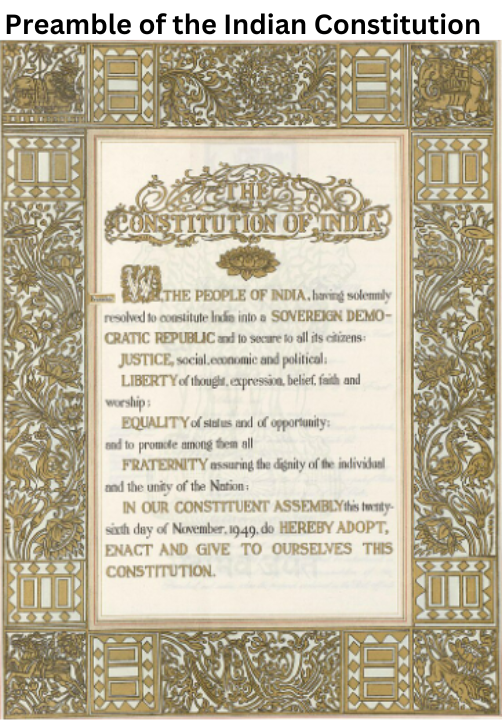Understanding the Preamble of the Indian Constitution is paramount for students preparing for upcoming exams. It encapsulates the essence, ideals, and objectives of the Constitution, serving as its guiding light. Mastery of the Preamble enables students to comprehend the foundational principles upon which India’s governance framework stands. Moreover, it fosters a deeper understanding of constitutional values such as justice, liberty, equality, and fraternity. Proficiency in this topic not only enriches students’ knowledge but also equips them with the analytical tools necessary for navigating complex legal and political concepts in their exams.

Also Read – 30 Major Amendments of Indian Constitution
Preamble of the Indian Constitution
The ‘Preamble’ of the Constitution of India is a brief introductory statement that sets out the guiding purpose and principles of the document, and it indicates the source from which the document which derives its authority, meaning, the people. It was adopted on 26 November 1949 and came into effect on 26th January 1950.
Historical Background of The Preamble
- Nehru introduced an Objectives Resolution (a resolution that outlined the Assembly’s goals) in 1946, before the constitution making process began.
- The aims and principles that drove the creation of the Constitution were embodied in this resolution.
- The Objectives Resolution provided the foundation for India’s Constitution, which institutionalized the essential values of equality, liberty, democracy, sovereignty, and cosmopolitan identity.
- This solidified the moral resolve to form a government that will carry out the many promises made by the nationalist movement to the Indian people.
- The Preamble to the Constitution is based on this resolution, which was overwhelmingly accepted on January 22, 1947.
- The essential framework of our constitution is included in the preamble’s goals. It emphasizes the Indian constitution’s key ideas and philosophy. It is regarded as the Constitution’s soul.
Objective of Preamble
- The Preamble’s objectives are to provide justice, liberty, and equality for all people, as well as to foster brotherhood to protect the nation’s unity and integrity.
Keywords in The Preamble
- The first line of the Preamble “We the people of India” shows that the people have ultimate power. It is a democracy in the true sense, meaning that it is governed of, for, and by the people.
- It reflects that the source of the authority of the Constitution lies with the people of India.
The Constitution of India states India to be a sovereign, socialist, secular democratic, and republican state.
Sovereignty
- The term “sovereignty” suggests that India is a sovereign state, not a dependency or a dominion of another country. It has no higher authority than it, and it is free to manage its own affairs (both internal and external).
Socialist
- Socialism believes in a “mixed economy,” in which the public and private sectors coexist. Indian socialism, according to the Supreme Court, aspires to eradicate poverty, ignorance, sickness, and inequity of opportunity.
Secularism
The Indian Constitution embodies the positive notion of secularism, which states that all religions in our country (regardless of their strength) enjoy the same status and support from the government.
Democratic
- The Indian Constitution establishes a representative parliamentary democracy in which the executive is held accountable for all policies and actions by the legislature.
- The democratic nature of the Indian polity is manifested through the periodic elections, judiciary independence, and the absence of discrimination on certain grounds.
Republic
- The term Republic in our Preamble denotes that India has a president who is elected by the people.
- India is democratic republic, meaning its offices are open to every citizen of India, unlike the UK where the highest office in the country is reserved for the monarchy.
Justice
- The term Justice is used in the Preamble to refer to three types of justice: social, economic, and political justice, all of which are guaranteed by various articles of the Directive Principles and Fundamental Rights.
Liberty
- The term Liberty refers to the absence of restrictions on individuals’ activities while also allowing for the development of individual personalities.
- The Preamble guarantees all Indian citizens the freedom of thought, expression, belief, faith, and worship through their Fundamental Rights, which can be enforced in a court of law if they are violated.
Equality
- The term Equality refers to the lack of special privileges for any group in society, as well as the availability of suitable opportunities for all people without discrimination.
- The Preamble guarantees equality of status and opportunity to all Indian citizens. This clause covers three aspects of equality: civil, political, and economic.
Fraternity
- Fraternity is defined as a feeling of brotherhood. By establishing a system of single citizenship, the Constitution fosters a sense of brotherhood.
- In addition, Article 51-A of the Fundamental Duties states that it is the duty of every citizen of India to foster harmony and the spirit of shared brotherhood among all Indians, regardless of religious, linguistic, regional, or sectional differences.
- The Preamble emphasizes that fraternity must guarantee two things: human dignity and national unity and integrity.
Significance of The Preamble
- Source of Authority: The Preamble declares that the Constitution derives its authority from the people of India. It emphasizes the democratic principle that the ultimate power lies with the citizens, reinforcing the idea that the Constitution is a document created by and for the people.
- Statement of Objectives: The Preamble outlines the objectives of the Constitution, which include securing justice, liberty, equality, and fraternity for all citizens. These values form the core principles upon which the Indian democratic system is built, and they guide the interpretation and implementation of other constitutional provisions.
- Unity in Diversity: The Preamble acknowledges the diversity of the Indian population and envisions a nation where unity is maintained amidst this diversity. It highlights the commitment to promoting a sense of brotherhood and fraternity among the people of India.
- Secularism: The term “secular” was added to the Preamble by the 42nd Amendment in 1976. This signifies the commitment of the Indian state to maintain religious neutrality and treat all religions with equal respect. It reflects the idea of a secular and inclusive society.
- Democratic Values: The Preamble emphasizes the democratic principles of justice, liberty, equality, and fraternity. It establishes the democratic form of government and a commitment to ensuring that the state functions in a manner that upholds these values.
- Guide for Constitutional Interpretation: Courts often refer to the Preamble while interpreting various provisions of the Constitution. It serves as a guiding light for the judiciary in understanding the intent and philosophy behind different constitutional provisions.
Amendments in The Preamble
42nd Constitutional Amendment
The 42nd Constitutional Amendment Act changed the Preamble for the first and the only time in 1976. Three additional terms: socialist, secular, and integrity were added with 42nd Amendment.
Preamble as Part of the Constitution – Supreme Court Interpretations
In Beriberi Union Case (1960)
- The Preamble is the key to the minds of the makers of the Constitution. The Supreme Court recognized that the Preamble might be used as a guiding principle if a term in any article of the Constitution is unclear or has more than one meaning.
- Despite this recognition of the Significance of the Preamble, Supreme Court Opined that the Preamble cannot take the place of the explicit provisions of the Law.
- The Supreme Court concluded in the Berubari case that because the Preamble is not part of the Constitution, it can never be regarded a source of significant power.
In the Kesavananda Bharati case (1973)
- In the Kesavananda Bharati case (1973), the Supreme Court Rejected earlier opinions and held that the Preamble is a part of the Constitution and can be amended under Article 368 of the Constitution.
- It is observed that the Preamble is of extreme importance and that the Constitution should be read and interpreted in the light of the grand and noble vision expressed in the Preamble.
Union Government v. LIC of India case (1995)
- The Supreme Court ruled in the LIC of India case that the Preamble is an integral part of the Constitution.
- Thus, the core ideas, purposes, and philosophical postulates that the Constitution of India stands for are contained in the Preamble to the Constitution of Free India.
Despite the above Supreme Court rulings, two things need to be noted –
- The Preamble is neither a source of power to the legislature nor a prohibition upon the powers of the legislature.
- It is non-justiciable, that is, its provisions are not enforceable in courts of law.
.
